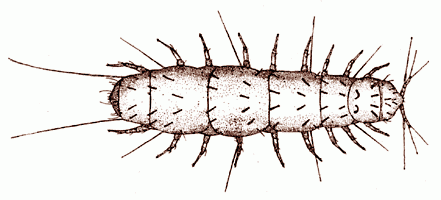Pauropoda (Pauropus huxleyi)
Scientific classification
Kingdom: Animalia
Phylum: Arthropoda
Subphylum: Myriapoda
Class: Pauropoda
Order: Pauropodina
Families
• Afrauropodidae
• Brachypauropodidae
• Millotauropodidae
• Pauropodidae
Pauropods are small, pale, centipede-like arthropods. They form the order Pauropodina, belonging to the monotypic class Pauropoda. About 500 species in four families are found worldwide, living in soil and leaf mold. They look rather like centipedes, but are probably the sister group to millipedes.
The name is derived from the Greek roots pauro "small" and podo "foot".
Evolution and systematics:
Though no fossil pauropods have been found from before the time of the Baltic amber (40 to 35 million years ago), they seem to be an old group closely related to the millipedes (Diplopoda). Their head capsules show great similarities to millipedes: both have three pairs of mouthparts and the genital openings occur in the anterior part of the body. Moreover, both groups have a pupoid phase at the end of the embryonic development. The two groups probably have a common origin.
There are two orders: Hexamerocerata and Tetramerocerata.Hexamerocerata has a 6-segmented and strongly telescopic antennal stalk and a 12-segmented trunk with 12 tergites and 11 pairs of legs. The representatives are white and proportionately long and large. The one family in this order, Millotauropodidae, has one genus and a few species.Tetramerocerata has a 4-segmented and scarcely telescopic antennal stalk, 6 tergites, and 8–10 pairs of legs. Representatives of this order are often small (sometimes very small), and white or brownish. Most species have nine pairs of legs as adults.The four families include Pauropodidae, Afrauropodidae, Brachypauropodidae, and Eurypauropodidae. Most genera and species belong to the family Pauropodidae.
Physical characteristics:
These white or brownish animals are relatively short, 0.5–2.0 millimetres (0.020–0.079 in), with a very flexible trunk. They are blind and have many partly unusual sensory organs. There are five pairs of long sensory hairs on the trunk. The antennae are complicated, biramous, with three flagellae. They are provided with different organs to help the animal analyze the surroundings, among them the end organs of the flagellae and the globulus at the distal part of the lower antennal branch.
There are 12 trunk segments, but the number of tergites is always less. The head is small, directed downwards, without eyes but with eyelike sensory organs. Behind the last trunk segment, there is an anal segment, the pygidium, which is horizontally divided. It has a most peculiar structure posteriorly, the anal plate (0.01–0.02 millimetre or 0.00039–0.00079 inch in diameter), which is the greatest factor for identification purposes. Almost every species has a unique plate that is characterized by its shape (form, size, cuticular structure) and, if any, its appendages (number, length, thickness, direction, surface structure, insertion points). Each species can be identified from this plate, even at the first larval stage.
Habitat:
In most environments, their occurrence is patchy and the population sparse. However, sometimes they have been reported to have several thousand specimens per square meter, even in agricultural habitats. They are easy to find under stones and molting tree branches that have good contact with the underlying moist soil. They are also under moss carpets. They inhabit many plant communities and soil types and are most abundant in a zone about 3.9–7.8 in (10–20 cm) deep. However, though they cannot burrow, they can follow root canals and crevices in much deeper levels, down to the groundwater surface.
Behavior:
Pauropods have a patchy occurrence and can often be found aggregated on the underside of stones and tree branches. They are most often swift runners, with mouse-like intermittent rushes. The species most often observed can turn its body almost 180°. Pauropods are shy of light and try to disappear in crevices and soil clumps as soon as possible. The antennae rotate constantly with an unusually high rapidity to examine the environment. The sexes are separate, and males deposit small spherical sperm-packets in the soil, which the females seek and pick up. Nothing is known about other types of social behavior and communication. Their display and territoriality are unknown. Vertical migration occurs when there are changes in soil moisture.
Ecology and diet:
The food habits of most species are unknown, but some can eat mold or suck out fungal hyphae; at least one species even eats root hairs. Most species move swiftly with intermittent rushes very much like a miniature mouse. Reduced agility occurs in the families Brachypauropodidae and Eurypauropodidae.
Significance to humans:
Pauropods are so small that they have often been over-looked, even by many trained soil zoologists. Consequently, pauropods are little known by the general public. A single species (Saintpaulia sp.) has recently been found feeding on and damaging cuttings in a greenhouse in the Netherlands. They are not dangerous to humans.
Dr. Benedek Pál : Mezőgazdasági állattan
Biológiai Nagy Lexikon; Oxford Typotex
www.doksi.hu ;www.wikipedia.hu
Hoczek László-Dr Folcz Tóbiás : Erdészeti állattan
